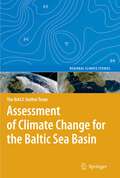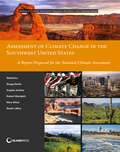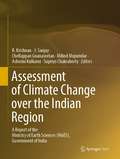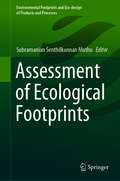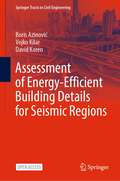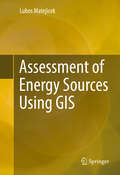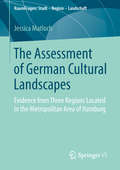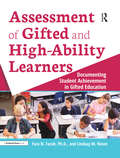- Table View
- List View
Assessment of Carbon Footprint in Different Industrial Sectors, Volume 1 (EcoProduction)
by Subramanian Senthilkannan MuthuCarbon footprint is one of the important environmental impacts, which has received greater attention from the public, government and media. It is one of the important topics of even any government’s agenda as well and every nation is trying its best to reduce its carbon footprint to the maximum possible extent. Every company would like to reduce the carbon footprint of its products and consumers are looking for the products which emit lower carbon emissions in their entire life cycle. Assessment of Carbon footprint for different products, processes and services and also carbon labelling of products have become familiar topics in the recent past in various industrial sectors. Every industry has its unique assessment and modelling techniques, allocation procedures, mitigation methods and labelling strategies for its carbon emissions. With this background, this book has been framed with dedicated chapters on carbon footprint assessment on various industrial sectors. In each chapter, details pertaining to the assessment methodologies of carbon footprint followed in a particular industry, challenges in calculating the carbon footprint, case studies of various products in that particular industry, mitigation measures to be followed to trim down the carbon footprint, recommendations for further research are discussed in detail. This first volume includes the carbon footprint assessment methodology of agricultural sector, telecommunication sector, food sector, ceramic industry, packaging industry, building and construction sector and solid waste sector.
Assessment of Carbon Footprint in Different Industrial Sectors, Volume 2 (EcoProduction)
by Subramanian Senthilkannan MuthuFollowed by the previous part (Volume-1), Volume-2 of carbon footprint assessment book deals with the assessment of carbon footprint in different other sectors, which were not dealt in the first part. Attention on Carbon footprint is growing day-by-day from the public, government and media. Certainly it is one of the most important topics in the agenda of every nation, which is trying its best to reduce its carbon footprint to the maximum possible extent. Every manufacturing industry or sector would like to reduce the carbon footprint of its products and consumers are looking for the products which emit lower carbon emissions in their entire life cycle. Assessment of Carbon footprint for different products, processes and services and also carbon labeling of products have become familiar topics in the recent past in various industrial sectors. Every industry has its unique assessment and modeling techniques, allocation procedures, mitigation methods and labeling strategies for its carbon emissions. With this background, volume two of this book has been framed with dedicated chapters on carbon footprint assessment on various industrial sectors, apart from the ones covered in Volume 1. In each chapter, details pertaining to the assessment methodologies of carbon footprint followed in a particular industry, challenges in calculating the carbon footprint, case studies of various products in that particular industry, mitigation measures to be followed to trim down the carbon footprint, recommendations for further research are discussed in detail.
Assessment of Cell Proliferation in Clinical Practice
by Peter A. Hall David A. Levison Nicholas A. WrightThe only book to attempt any perspective on methods of assessing cell proliferation is published to satisfy the growing interest amongst pathologists and clinicians in areas which have for more than three decades been the preserve of experimental biologists
Assessment of Chemical Exposures: Calculation Methods for Environmental Professionals
by Jack E. DaughertyTraditionally, industrial hygienists and environmental engineers have been responsible for conducting chemical exposure assessments, however, this task is now becoming a team effort taken on by scientists, businessmen, and policymakers. Assessment of Chemical Exposures: Calculation Methods for Environmental Professionals addresses the expanding scope of exposure assessments in both the workplace and environment. It discusses the basics of gathering data and assessing exposure, including how to estimate exposure to chemicals using fundamental chemical engineering concepts. The book opens with a brief discussion on the history of exposure assessments and provides terms and nomenclature needed for communications between various disciplines involved in exposure assessments. The potential impact of chemical exposures on humans, the environment, and communities is discussed in detail The book also addresses modeling source generation, pathway transport, and receptor impact. With the clear explanations presented in this text, even a novice will be able to practice the art of exposure assessment.
Assessment of Chemical Exposures: Calculation Methods for Environmental Professionals
by Jack E. DaughertyTraditionally, industrial hygienists and environmental engineers have been responsible for conducting chemical exposure assessments, however, this task is now becoming a team effort taken on by scientists, businessmen, and policymakers. Assessment of Chemical Exposures: Calculation Methods for Environmental Professionals addresses the expanding scope of exposure assessments in both the workplace and environment. It discusses the basics of gathering data and assessing exposure, including how to estimate exposure to chemicals using fundamental chemical engineering concepts. The book opens with a brief discussion on the history of exposure assessments and provides terms and nomenclature needed for communications between various disciplines involved in exposure assessments. The potential impact of chemical exposures on humans, the environment, and communities is discussed in detail The book also addresses modeling source generation, pathway transport, and receptor impact. With the clear explanations presented in this text, even a novice will be able to practice the art of exposure assessment.
Assessment of Client Core Issues
by Richard W. HalsteadThis monograph instructs counselors on how to better recognize, understand, and treat clients’ underlying problems. The model presented helps uncover the origin of these core concerns, provides a means to address them, and challenges counselors to move beyond the DSM to better serve their clients. This framework will also assist counselors in providing more targeted treatment plans. *Requests for digital versions from the ACA can be found on wiley.com. *To request print copies, please visit the ACA website.
Assessment of Client Core Issues
by Richard W. HalsteadThis monograph instructs counselors on how to better recognize, understand, and treat clients’ underlying problems. The model presented helps uncover the origin of these core concerns, provides a means to address them, and challenges counselors to move beyond the DSM to better serve their clients. This framework will also assist counselors in providing more targeted treatment plans. *Requests for digital versions from the ACA can be found on wiley.com. *To request print copies, please visit the ACA website.
Assessment of Climate Change for the Baltic Sea Basin (Regional Climate Studies)
by BACC Author TeamThis book offers an up-to-date overview of the latest scientific findings in regional climate research on the Baltic Sea basin. This includes climate changes in the recent past, climate projections up until 2100 using the most sophisticated regional climate models available, and an assessment of climate change impacts on terrestrial, freshwater and marine ecosystems. The authors demonstrate that the regional climate has already started to change, and will continue to do so.
Assessment of Climate Change in the Southwest United States: A Report Prepared for the National Climate Assessment (NCA Regional Input Reports)
by Gregg Garfin, Angela Jardine, Robert Merideth, Mary Black and Sarah LeRoyA landmark study in terms of its breadth and depth of coverage, this book provides the most comprehensive, and understandable, analysis to date about climate and its effects on the people and landscapes of Arizona, California, Colorado, Nevada, New Mexico, and Utah—including the U.S.-Mexico border region and the lands of Native Nations.
Assessment of Climate Change over the Indian Region: A Report of the Ministry of Earth Sciences (MoES), Government of India
by R. Krishnan J. Sanjay Chellappan Gnanaseelan Milind Mujumdar Ashwini Kulkarni Supriyo ChakrabortyThis open access book discusses the impact of human-induced global climate change on the regional climate and monsoons of the Indian subcontinent, adjoining Indian Ocean and the Himalayas. It documents the regional climate change projections based on the climate models used in the IPCC Fifth Assessment Report (AR5) and climate change modeling studies using the IITM Earth System Model (ESM) and CORDEX South Asia datasets. The IPCC assessment reports, published every 6–7 years, constitute important reference materials for major policy decisions on climate change, adaptation, and mitigation. While the IPCC assessment reports largely provide a global perspective on climate change, the focus on regional climate change aspects is considerably limited. The effects of climate change over the Indian subcontinent involve complex physical processes on different space and time scales, especially given that the mean climate of this region is generally shaped by the Indian monsoon and the unique high-elevation geographical features such as the Himalayas, the Western Ghats, the Tibetan Plateau and the adjoining Indian Ocean, Arabian Sea, and Bay of Bengal. This book also presents policy relevant information based on robust scientific analysis and assessments of the observed and projected future climate change over the Indian region.
Assessment of Crop Loss From Air Pollutants
by W. W. Heck O. C. Taylor TingeyDuring late 1985, the Research Management Committee (RMC) of the National Crop Loss Assessment Network (NCLAN) decided the most ap propriate way to bring the NCLAN program to a successful conclusion was to hold an international conference. It was envisaged as an opportunity to present an overview of results from the NCLAN program and as a chance to view the results in the context of ongoing research by members of the international community. * Although we wanted the Conference to have an assessment orientation, it was also intended for the Conference to focus on current state-of-knowledge. The Conference was designed to overview the needs of crop loss assessment, current approaches to assessment, progress in the development of predictive models, the use of the information for economic predictions, and the application of the data in policy decisions. Every effort was made to assure a broad representation of ideas. The Conference program was developed to evaluate major issues that address regional/national assessments of impacts of atmospheric pollutants on agricultural production. Sessions were structured to address specific issues by invited speakers, and by contributed papers and posters. First, background needs for doing loss assessment research including specific approaches and a rather detailed review of the NCLAN program were addressed (Session I). Session II addressed the needs for defining the exposure environment (e. g. extrapolating to regional concentrations and exposure characterization). Field approaches for determining crop loss were reviewed in Session III.
Assessment of Depression
by Dr Norman Sartorius Dr Thomas A. BanPublished on Behalf of the World Health Organization
Assessment of Ecological Footprints (Environmental Footprints and Eco-design of Products and Processes)
by Subramanian Senthilkannan MuthuThis book highlights the concepts and assessment methods of Ecological Footprints. Ecological footprint is defined as, ”a measure of how much area of biologically productive land and water an individual, population or activity requires to produce all the resources it consumes and to absorb the waste it generates, using prevailing technology and resource management practices”. Developed in 1992 by William Rees, it was the first footprint developed followed by other footprints such as Carbon, Water and Energy. Assessment of Ecological footprints strive for comparing consumption footprint to biological capacity. This book presents five interesting chapters pertaining to the assessment of Ecological Footprints.
Assessment of Energy-Efficient Building Details for Seismic Regions (Springer Tracts in Civil Engineering)
by Boris Azinović Vojko Kilar David KorenThis open access book presents a methodology for the assessment of structural building details, taking into account the contemporary guidelines for earthquake-resistant and energy-efficient buildings. A review of structural details for energy-efficient buildings revealed that in some cases the structural system is interrupted, leading to solutions which are not suitable for earthquake-prone regions. Such typical examples would be the use of thermal insulation under the building foundation and reduction of the load-bearing elements’ dimensions – also at the potential locations of plastic hinges which are crucial for the dissipation of seismic energy. The proposed methodology of assessment favours a collaboration of architects, engineers, contractors and investors in the early stage of building design. By this the methodology enables efficient decision-making and contributes to a selection of optimal building structural details.The book starts by presenting the typical structural details of the thermal envelope of energy-efficient buildings together with the scientific background required for understanding the process of detail development from all the relevant aspects. Over 20 examples of most frequent details are described and analysed to raise awareness of the importance of earthquake resistance, sustainability, energy-efficiency and thermal comfort for users.
Assessment of Energy Sources Using GIS
by Lubos MatejicekThis volume is a comprehensive guide to the use of geographic information systems (GIS) for the spatial analysis of supply and demand for energy in the global and local scale. It gathers the latest research and techniques in GIS for spatial and temporal analysis of energy systems, mapping of energy from fossil fuels, optimization of renewable energy sources, optimized deployment of existing power sources, and assessment of environmental impact of all of the above. Author Lubos Matejicek covers GIS for assessment a wide variety of energy sources, including fossil fuels, hydropower, wind power, solar energy, biomass energy, and nuclear power as well as the use of batteries and accumulators. The author also utilizes case studies to illustrate advanced techniques such as multicriteria analysis, environmental modeling for prediction of energy consumption, and the use of mobile computing and multimedia tools.
Assessment of Environmental Impact by Grocery Shopping Bags: An Eco-Functional Approach (EcoProduction)
by Subramanian Senthilkannan Muthu Yi LiThis book reviews the manufacturing processes of different shopping bags used for grocery purposes, life cycle impacts, modelling of life cycle impacts, carbon and eco-footprints in different countries, consumption of shopping bags in different countries, consumer behaviour of shopping bags in various countries and its relation to eco-impact, assessment of functionality of shopping bags, concept and framework of eco-functional assessment of shopping bags, biodegradation of shopping bags, etc.
Assessment of Failed Federalism in Iraq: Federal in Name Only
by Hemin R.A. AkreyiAkreyi investigates the development of federal relations in Iraq from the adoption of the new Federal Constitution in 2005 to the Kurdistan independence referendum in 2017.The book highlights the dysfunctionality of the Iraqi federal system even after the independence referendum and shows the true picture of the key issues between the Kurdistan Region and the Iraqi government in Baghdad. This informative content is presented in an easy-to-grasp manner, originating primarily from face-to-face interviews with relevant elites and decision-makers in Iraq as well as foreign diplomats.A valuable source for academics, researchers, journalists, and students of politics and international relations at the undergraduate and postgraduate levels in all universities, especially in the West and Middle East.
Assessment of Failed Federalism in Iraq: Federal in Name Only
by Hemin R.A. AkreyiAkreyi investigates the development of federal relations in Iraq from the adoption of the new Federal Constitution in 2005 to the Kurdistan independence referendum in 2017.The book highlights the dysfunctionality of the Iraqi federal system even after the independence referendum and shows the true picture of the key issues between the Kurdistan Region and the Iraqi government in Baghdad. This informative content is presented in an easy-to-grasp manner, originating primarily from face-to-face interviews with relevant elites and decision-makers in Iraq as well as foreign diplomats.A valuable source for academics, researchers, journalists, and students of politics and international relations at the undergraduate and postgraduate levels in all universities, especially in the West and Middle East.
The Assessment of German Cultural Landscapes: Evidence from Three Regions Located in the Metropolitan Area of Hamburg (RaumFragen: Stadt – Region – Landschaft)
by Jessica MatlochJessica Matloch examines the importance of regional cultural landscape for their residents using the approach of willingness to pay. She identifies that almost each resident of every region prefers water landscapes. Furthermore, landscape perception is often influenced by education and by the resident’s relationship with nature. The impact of the relationship to the region differs between regions and resident groups. Regarding the involvement in or for the landscape, the results suggest that specific groups of residents are more willing to volunteer in and for regional landscapes than others. The analyses illustrate that the region is used the most to relax and the least for cultural purposes.
Assessment of Gifted and High-Ability Learners: Documenting Student Achievement in Gifted Education
by Joan L. GreenAssessment of Gifted and High-Ability Learners equips readers with the knowledge and skills to evaluate and document student progress using a cyclical systematic process. This book:
Assessment of Gifted and High-Ability Learners: Documenting Student Achievement in Gifted Education
by Joan L. GreenAssessment of Gifted and High-Ability Learners equips readers with the knowledge and skills to evaluate and document student progress using a cyclical systematic process. This book:
Assessment of Hydrogen Energy for Sustainable Development (NATO Science for Peace and Security Series C: Environmental Security)
by John W. Sheffield Çigdem SheffieldFossil fuel prices continue to rise and, at the same time, environmental policies are demanding a reduction in greenhouse gases and toxic emissions. A coherent energy strategy is needed: one that addresses both energy supply and demand and takes into account the whole energy lifecycle, from fuel production to the end-users of energy systems. This book examines hydrogen energy technologies and infrastructure development.
The Assessment of Industrial Markets (Routledge Revivals)
by Aubrey WilsonFirst Published in 1968, The Assessment of Industrial Markets offers a quite different approach to the subject of industrial marketing research. It concentrates on the techniques of industrial marketing research and devotes a chapter to each major method. More space is also given to the mechanics of research. The author’s purpose has been to set out clearly the salient factors and methodologies. Chapter demographics refer the reader to more detailed or advanced reading on any particular aspect of industrial marketing.The book is essentially practical and contains an important innovation. Where appropriate, checklists have been developed for the processes and actions required in a number of industrial marketing activities. Also, the checklist which appeared in Industrial Marketing Research is included in the present work in a revised and extended form. This is a must read for students of marketing, business management and business economics.
The Assessment of Industrial Markets (Routledge Revivals)
by Aubrey WilsonFirst Published in 1968, The Assessment of Industrial Markets offers a quite different approach to the subject of industrial marketing research. It concentrates on the techniques of industrial marketing research and devotes a chapter to each major method. More space is also given to the mechanics of research. The author’s purpose has been to set out clearly the salient factors and methodologies. Chapter demographics refer the reader to more detailed or advanced reading on any particular aspect of industrial marketing.The book is essentially practical and contains an important innovation. Where appropriate, checklists have been developed for the processes and actions required in a number of industrial marketing activities. Also, the checklist which appeared in Industrial Marketing Research is included in the present work in a revised and extended form. This is a must read for students of marketing, business management and business economics.
Assessment of Inhalation Hazards: Integration and Extrapolation Using Diverse Data (ILSI Monographs)
by Ulrich Mohr David V. Bates Donald L. Dungworth Peter N. Lee Roger O. McClellan Francis J.C. RoeThe International Life Sciences Institute (ILSI), a nonprofit, public foundation, was established in 1978 to advance the sciences of nutrition, toxicology, and food safety. ILSI promotes the resolution of health and safety issues in these areas by sponsoring research, conferences, publications, and educational programs. Through ILSI's programs, scientists from government, academia, and industry unite their efforts to resolve issues of critical importance to the public. As part of its commitment to understanding and resolving health and safety issues, ILSI is pleased to sponsor this series of monographs that consolidates new scientific knowledge, defines research needs, and provides a background for the effective application of scientific advances in toxicology and food safety. Alex Malaspina President International Life Sciences Institute Contents Series Foreword . . . . . . . . . . . . . . . . . . . . . . . . . . . . . . . . . . . . . . . . . . . . . . v Contributors . . . . . . . . . . . . . . . . . . . . . . . . . . . . . . . .. . . . xiii . . . . . . . . . . . . . Part I. Integrative Approach to Assessing Human Health Risk: Two Contemporary Problems Chapter 1. Integrating Diverse Data Sets to Assess the Risks of Airborne Pollutants . . . . . . . . . . . . . . . . . . . . . . . . . . . . . . . 3 R.o. McClellan, R.G. Cuddihy, w.e. Griffith, and J. L. Mauderly Chapter 2. Risk Assessment for Radon Inhalation Based on Animal Exposure Data and Human Epidemiology . . . . . . . 23 . F. Steinhausler Part II. Types of Evidence: General Strengths and Weaknesses Section 1. Epidemiological Chapter 3. Inhalation Hazards: The Interpretation of Epidemiologic Evidence. . . . . . . . . . . . . . . . . . . . 39 . . . . . . . J.e. Bailar Chapter 4. Problems in Interpreting Epidemiological Data 49 P.N. Lee Section 2. Animal Chapter 5. Rodent Carcinogenicity Studies: Their Value and Limitations. . . . . . . . . . . . . . . . . . . . . . . . . . 61 . . . . . . . . . .





